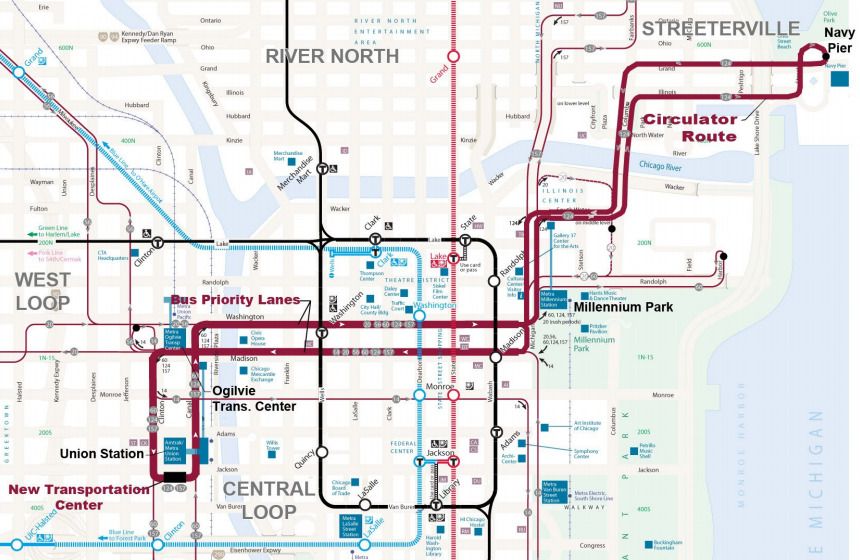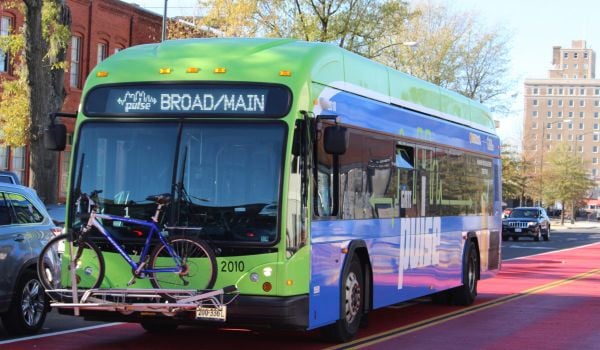This piece originally ran on The Transport Politic.
A year and a half after Chicago won $24.6 million in federal funds for the construction of an urban circulator downtown, the city announced this week that it will contribute $7.3 million in tax increment financing to improve the state of bus service in the urban center and link commuter rail stations to office buildings. Together, the money will provide for painting dedicated bus lanes on the Madison/Washington and Clinton/Canal Street pairs for a total of two miles, offer signal priority, improve bus shelters and add bike lanes. New buses and a small bus transit center at Union Station are also part of the plan.
Though the improvements will be most visible to customers using the new dedicated “Central Area Transitway” connecting Union Station and the Navy Pier northeast of the loop, the new lanes will also be used by seven existing Chicago Transit Authority bus routes which already collectively carry 32,000 riders a day on 1,700 buses.
There is nothing new about the idea of improved circulator service in Chicago’s downtown core. Following the failed efforts of planners in the 1960s and 1970s to expand the city’s subway system, Mayor Richard M. Daley announced in his first year of office (1989) that he wanted to construct a center-city light rail line linking major tourist attractions, commuter rail stations and the business center. By 1993, the plan had morphed into a $775-million proposal that would include eight miles of median-running track designed to carry four routes—the first running east-west along Madison and/or Monroe Streets between Oglivie Transportation Center and Michigan Avenue; the second heading north-south along the river to Navy Pier; the third running south to McCormick Place Convention Center; and the fourth heading north to the Magnificent Mile of North Michigan Avenue.
The plan came surprisingly close to being realized. The federal and state governments each agreed to chip in $250 million, and local businesses in the Loop—concerned about their ability to compete with retailers on North Michigan Avenue and convinced of the importance of linking commuter rail passengers to the center—agreed to a special tax district that would also raise $250 million. The project would have reshaped the image of and mobility in Chicago’s inner core.
Yet in fall 1993, the U.S. Congress cut off most funding for the project. In 1995, the state pulled out of its share. Business leaders suggested they might double or triple their contribution to the project through neighborhood taxes, but North Michigan Avenue leaders pushed back, suggesting the project gave an unfair advantage to retailers in the Loop. The project died. By 2006, hoping to do something, the city had settled on the idea of a Navy Pier-Union Station busway.
Unlike these previous plans, the new proposal for Chicago will offer only minimal improvements to circulation in the downtown core: Customers will save an estimated 1.1 minutes on travel between Union Station and Michigan Avenue. The priority lanes will be beneficial, but buses will continue to stop at almost every cross street on Madison and Washington, limiting the amount of travel time that can actually be reduced. And the focus on serving the Navy Pier—a tourist trap that is scheduled for a major renovation–speaks to the limited degree to which this route will serve actual commuters.
Nevertheless, the connection between the commuter rail stations west of the Loop and the central business core provided by the bus link will offer the potential for improved circulation downtown. Improved service to Union Station must be a priority, since it is not linked to the L rail rapid transit network (the nearest station is about half a mile away) and it is the focus of the region’s commuter rail and intercity rail improvement efforts. The seven bus lines that will share parts of the route will split off and continue to other parts of the city, meaning that customers who are arriving on the #14 from Jeffery in the South Side, for instance, will have a quicker trip once they reach downtown.
If the CTA designs signage well enough, customers attempting to make the trip from Oglivie Transportation Center—another commuter rail station—to Millennium Park would have six services to choose from, offering fantastic headways of one minute at peak and two minutes off-peak. But the city will have to be careful not to place too much emphasis on the “Central Area Transitway” brand that it will give to the bus that runs the full route from Union Station to Navy Pier, because the most important element of this improvement project is its provision of minor improvements to many bus lines, not just a single one. It should be clear to customers that if they want to take a certain trip, they have several options.
Under Mayor Rahm Emanuel’s leadership, Chicago is taking an incremental approach to the improvement of public transportation in the city, steering away from the mega-fantasies of the Daley era. The CTA is already planning to invest in similar bus priority improvements on Jeffery Boulevard in the South Side for the #14 bus and along the north-south spine of Western Avenue as part of a citywide BRT plan that would fill in the gaps missing from inadequate rail service in certain areas. Slowly but surely, the city’s bus lines are scheduled for improvement.
Yet the city’s bigger ambitions remain apparent. In the application for the federal urban circulator grant in 2010, the city included the following map, documenting potential new transit routes for the center city along dedicated rights-of-way, clearly modeled after the improvements suggested by the 2009 Central Area Action Plan, which proposed light rail lines on the Carroll, Clinton, Monroe and Lakefront Corridors. They would either be placed underground or along dedicated transit routes, like the McCormick Center busway (for the Lakefront route).
For lack of funding, it will be a long time before any such routes see the light of day. In the meantime, painting a few bus lanes and offering existing lines priority at signals represent a reasonable step forward.

Yonah Freemark is a senior research associate in the Metropolitan Housing and Communities Policy Center at the Urban Institute, where he is the research director of the Land Use Lab at Urban. His research focuses on the intersection of land use, affordable housing, transportation, and governance.















